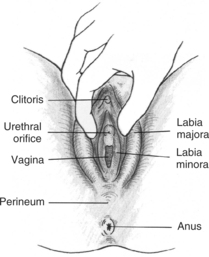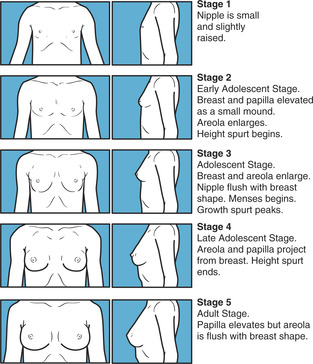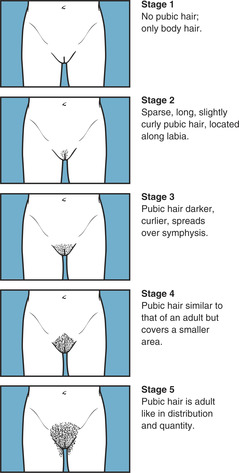Chapter 19. Reproductive System
Rationale
Examination of the external genitalia enables screening for common disorders that arise from prenatal development and influences. Examination enables the nurse to detect infections that require further evaluation. Assessment of the reproductive system often provides a beginning point for teaching and discussion related to sexuality and hygiene.
Anatomy and Physiology
Female Genitalia
The female genitalia includes the external and internal sex organs. The external sex organs, or vulva, include the mons pubis, a fatty pad overlying the symphysis pubis (Figure 19-1); the labia majora, rounded folds of adipose tissue extending down and back from the mons pubis; the labia minora, two thinner folds of skin medial to the labia majora, which, following prominence in the newborn period, atrophy to become nearly invisible until adolescence; and the clitoris, an erectile body situated at the anterior end of the labia minora. The labia minora are homologous to the male scrotum, and the clitoris to the male penis. Underlying the labia minora is a boat-shaped area termed the vestibule. At the posterior end of the vestibule is the vaginal opening, or introitus, which can be partially obscured by the hymen, a vascular mucous membrane. The perineum is the area between the vaginal opening and the anus. The urethral opening, or urinary meatus, lies between the vaginal opening and the clitoris. On either side of the urethral opening can be seen Skene’s glands, or the paraurethral ducts. Bartholin’s glands, which secrete lubricating fluid during intercourse, are situated on either side of the vaginal opening, but the openings to the glands usually cannot be seen.
 |
| Figure 19-1External female genitalia.(From Potter PA, Perry AG: Basic nursing: theory and practice, ed 4, St Louis, 1999, Mosby.)Elsevier Inc. |
The vagina is a hollow tube extending upward and backward between the urethra and the rectum. The cervix joins the vagina, which has a slitlike opening, termed the external os, that provides an opening between the uterus and the endocervical canal. The uterus is a muscular pear-shaped organ suspended above the bladder. In the prepubescent girl the uterus is 2.5 to 3.5 cm (1 to 1.4 in) long, compared with 6 to 8 cm (2.4 to 3.2 in) in the mature woman. The uterine, or fallopian, tubes extend from the uterus to the ovaries and produce a passageway in which ova and sperm meet.
The external male genitalia include the penis and scrotum. The penis consists of a shaft and a glans (Figure 19-2). The shaft is formed primarily of erectile tissue. The glans is a cone-shaped structure at the end of the penis and contains both erectile and sensory tissue. The corona is the crownlike area where the glans arises from the shaft. A loose fold of skin, termed the prepuce or foreskin, overlies the glans. This skin is removed during circumcision. The urethra is within the penile shaft, with the slitlike urethral meatus located slightly centrally at the tip of the glans.
 |
| Figure 19-2Male genitalia.(From Whaley LF, Wong DL: Nursing care of infants and children, ed 4, St Louis, 1991, Mosby.)Elsevier Inc. |
The scrotum is a loose, wrinkled sac located at the base of the penis. The scrotum has two compartments, each of which contains a testis, epididymis, and parts of the vas deferens. The testes, epididymis, and vas deferens are considered internal male sex organs.
The testes are ovoid and somewhat rubbery. The testes in the infant are 1.5 cm (0.6 in) long. Testicular length remains virtually unchanged until puberty, when the testes gradually enlarge to the adult length of 4 to 5 cm (1.6 to 2 in). The left testis lies slightly lower than the right. Primary functions of the testis are sperm and hormone production. During ejaculation, sperm drains into the epididymis, and then into the vas deferens before passing into the urethra.
The genetic sex type of the embryo begins during cell division, when X and Y chromosomes are distributed. Initially, internal and external genitalia are not differentiated (Figure 19-3, A). External differentiation begins by about the seventh week of gestation. Under the influence of androgens, enlargement and fusion of primitive urogenital structures occurs and male genitalia are formed (Figure 19-3, B). The testes descend from the abdominal cavity at between 7 and 9 months of gestation. If the tube that precedes their descent fails to close, an indirect inguinal hernia is produced.
 |
| Figure 19-3Initial stages in embryonic genital development. A, Undifferen-tiated stage. B, Initial differentiation of external genitalia in male embryo. C, Initial differentiation of external genitalia in female embryo. |
The male reproductive system remains unchanged until maturity. Testicular enlargement is a visible sign of sexual maturation, which can begin by 10 years of age. Accompanying the initial increase in testicular size are a coarsening, reddening, and wrinkling of the scrotal sacs and the growth of a few pubic hairs (the child has no pubic hair). Height and weight increase, and hair growth appears on the face about 2 years after the appearance of pubic hair. During further development the penis enlarges, the voice changes, and body odor appears. The genital skin continues to pigment and the external sex organs continue to enlarge until full maturation is reached. At maturity pubic hair covers the symphysis pubis and medial aspects of the thighs. Reproductive capability accompanies sexual maturity, which is accomplished between 14 and 18 years of age.
In the embryo, development of female genitalia involves shrinkage and minimal fusion of primitive urogenital structures (Figure 19-3, C). Primordial follicles are formed during the sixth month of gestation, but must wait until puberty for further development. Breast development is usually the first sign of sexual maturation, although growth of pubic hair can precede breast enlargement. The initial pubic hair, located at the sides of the labia, is fine. Gradually the hair coarsens and covers the sides of the labia and the perianal area at full maturation. Internal and external sex organs enlarge. The onset of menstruation provides observable evidence of reproductive maturation (Figure 19-4).
 |
 |
| Figure 19-4Tanner stages in development of secondary sexual characteristics in females. |
Equipment for Assessment of Reproductive System
▪ Glove for pelvic examination
▪ Drape
▪ Speculum
Preparation
A casual, matter-of-fact approach facilitates examination of the reproductive system. Much of the examination can be accomplished during assessment of the abdomen and anus in the infant and young child. Inform parents (if appropriate) and child of results of the finding as the assessment progresses because this helps relieve anxiety. A child other than an infant should be adequately covered at all times with clothing, such as a top that opens in the front, or a drape. Alternative positions for examination, such as semisitting on the parent’s lap, with the child’s feet on the nurse’s knees, might be more comfortable. An adolescent should be given the option of having a supportive person, such as a friend, present during examination. It is important to ensure privacy and confidentiality and if a parent is present, it must be made clear the adolescent is the patient by directing questions at him or her. It is important to recognize that children and parents from some cultures (e.g., Hispanic) are particularly modest and might require additional assistance to become comfortable.
The first pelvic examination is usually performed when the female child is 18 to 21 years old or as soon as she becomes sexually active, when there is a history of trauma or abuse, when there is vaginal discharge, menorrhagia, primary amenorrhea, secondary amenorrhea for more than 3 months, abdominal pain, or at the adolescent’s request. Adolescents at high risk (sexual intercourse before 18 years, multiple partners, intercourse without a condom, partners with history of intercourse, smoking, sexually transmitted diseases, and absence of three consecutive, negative Pap smears) should be screened yearly.
Buy Membership for Pediatrics Category to continue reading. Learn more here






